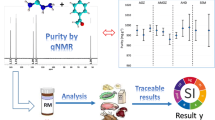Abstract
The purities of two high-purity organic compounds with a nitroxyl radical moiety were quantified based on their free-radical content using the effective magnetic-moment method. Magnetic moments were measured and X-band electron paramagnetic resonance (EPR) spectra were obtained using a superconducting quantum interference device and X-band EPR spectrometer, respectively, over a wide temperature range of near-room temperature to near-liquid-helium temperature. Concerning measurements of effective g-values using an EPR spectrometer, both the sweep direction and sweep speed were taken into account to obtain accurate g-values. The purities of 2,2,6,6-tetramethylpiperidine 1-oxyl (TEMPO) and 4-hydroxy-2,2,6,6-tetramethylpiperidine 1-oxyl benzoate (4-hydroxy-TEMPO benzoate) were close to 1 kg kg−1 with relative uncertainties of 1%, which represented improved values compared to those obtained by us previously. These results show a possibility for both compounds to act as reference materials in providing reliable quantification of free radicals per unit mass using this analytical method.
Similar content being viewed by others
References
ISO Guide 35-2006, “Reference Materials-General and Statistical Principles for Certification”, 3rd ed., 2006, International Organization for Standardization, Switzerland, 31.
D. A. Skoog, D. M. West, F. J. Holler, and S. R. Crouch, “Analytical Chemistry: An Introduction”, 7th ed., 2000, Harcourt College Publishers, Orlando, Florida, 699.
M. J. T. Milton and T. J. Quinn, Metrologia, 2001, 38, 289.
N. Matsumoto and T. Shimosaka, J. Appl. Phys., 2015, 117, 17E114.
N. Matsumoto and K. Kato, Metrologia, 2012, 49, 530.
N. Matsumoto and T. Shimosaka, Accredit. Qual. Assur., 2015, 20, 115.
N. Matsumoto, Bunseki, 2016, 63.
C. Kittel, “Introduction to Solid State Physics”, 7th ed., 1996, Chap. 14-15, John Wiley & Sons, Inc., New York.
C. Corvaja, “Electron Paramagnetic Resonance: A Practitioner’s Toolkit”, ed. M. Burustolon and E. Giamello, 2009, John Wiley & Sons, Inc., NJ, 8.
M. Kohno, T. Yoshikawa, and T. Ozawa, “Introduction to Electron Spin Resonance for Bioscientists”, 2011, Chap. 2, Kodansha Ltd., Tokyo.
R. Shvartzman-Cohen, I. Monje, and M. Florent, Macromolecules, 2010, 43, 606.
S. Ruthstein and D. Goldfarb, J. Phys. Chem. C, 2008, 112, 7102.
S. Ruthstein, A. Potapov, and A. M. Raitsimring, J. Phys. Chem. B, 2005, 109, 22843.
Y. S. Karimov and E. G. Rozantsev, Soviet Phys. Solid State, 1967, 8, 2225.
Y. S. Karimov ZhETF Pis’ma Red, 1968, 8, 239.
J. Yamauchi, Bull. Chem. Soc. Jpn., 1971, 44, 2301.
T. Yoshioka, Bull. Chem. Soc. Jpn., 1977, 50, 1372.
K. Takeda, N. Uryu, M. Inoue, and J. Yamauchi, J. Phys. Soc. Jpn. 1987, 56, 736.
M. Kohno, “Electron Spin Resonance”, 2003, Ohmsha, 47.
P. H. Rieger, “Electron Spin Resonance: Analysis and Interpretation”, 2007, RSC Publishing, Cambridge, 102.
P. Gans, “Data Fitting in the Chemical Sciences by the Method of Least Squares”, 1992, Wiley, Chichester, 30–34.
W. E. Deming, “Statistical Adjustment of Data”, 1943, John Wiley and Sons, Inc., New York.
S. Blundell, “Magnetism in Condensed Matter”, 2001, Oxford University Press, New York, 29.
D. Ondercin, T. Sandreczki, and R. W. Kreilick, J. Magn. Reson., 1979, 34, 151.
T. Fujito, Bull. Chem. Soc. Jpn., 1981, 54, 3110.
K. Mukai, H. Nishiguchi, and Y. Deguchi, J. Phys. Soc. Jpn., 1967, 23, 125.
T. Kebukawa, Prog. Theor. Phys., 1985, 74, 1.
Acknowledgments
A part of this work was conducted in the AIST Nano-Processing Facility supported by the Nanotechnology Platform Program (Nanofabrication), part of the Ministry of Education, Culture, Sports, Science and Technology (MEXT), Japan. Low-temperature EPR measurements were conducted at the Institute for Molecular Science, National Institutes of Natural Sciences, supported by the Nanotechnology Platform Program (Molecule and Material Synthesis) under the same ministry. Part of this work was supported by JSPS KAKENHI Grant Nos. 24750077 and 17K05918.
Author information
Authors and Affiliations
Corresponding author
Rights and permissions
About this article
Cite this article
Matsumoto, N., Shimosaka, T. Low-temperature Electronic Paramagnetic Resonance Measurements of TEMPO and 4-Hydroxy-TEMPO Benzoate for Purity Analyses by the Effective Magnetic-moment Method. ANAL. SCI. 33, 1059–1065 (2017). https://doi.org/10.2116/analsci.33.1059
Received:
Accepted:
Published:
Issue Date:
DOI: https://doi.org/10.2116/analsci.33.1059



